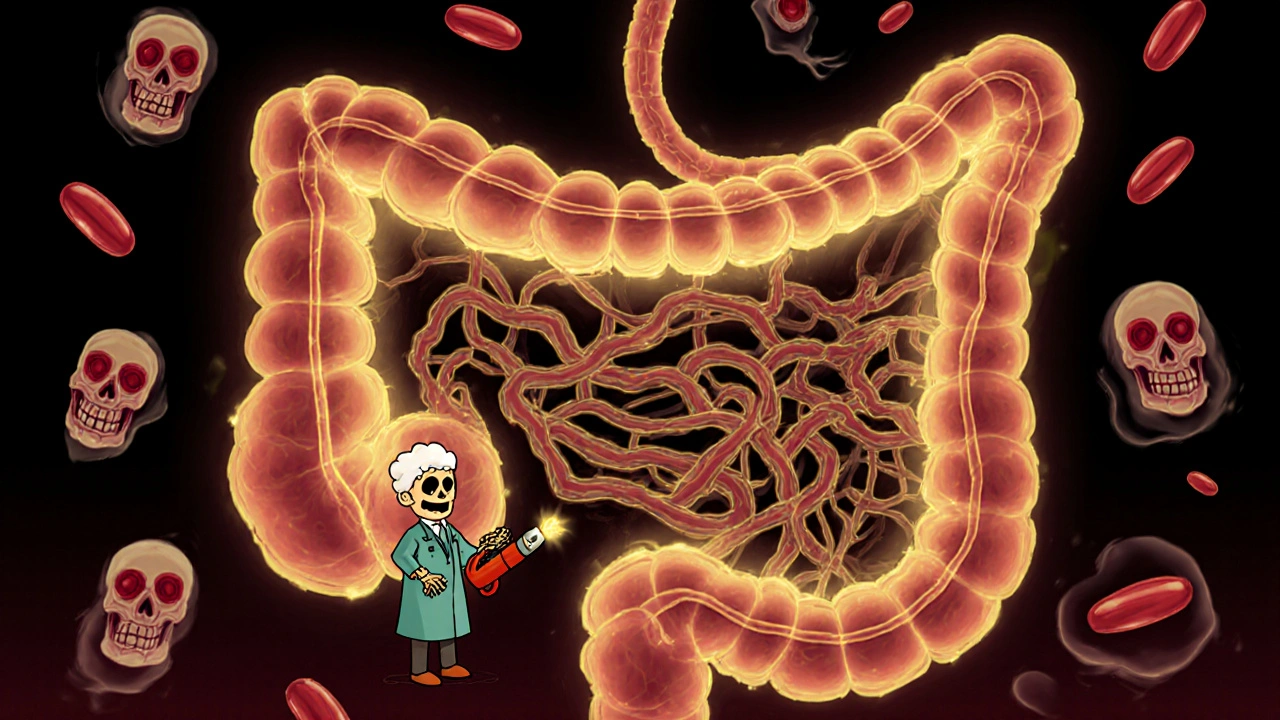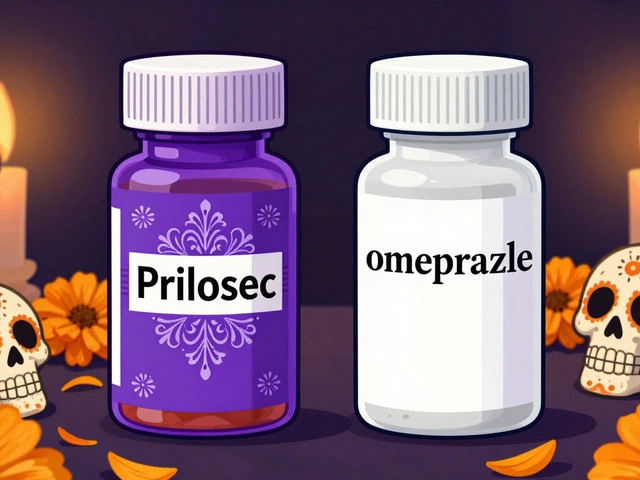When you see bright red blood in your stool, it’s scary. You might think it’s just hemorrhoids. But for many people over 60, it could be something more serious-like diverticula or angiodysplasia. These are two of the most common causes of lower GI bleeding, and knowing the difference can mean the difference between a quick fix and a long, frustrating journey.
What Exactly Is Lower GI Bleeding?
Lower gastrointestinal (GI) bleeding means blood is coming from somewhere in your colon or rectum-anything past the ligament of Treitz, which is deep in your small intestine. The most obvious sign? Bright red or maroon blood in your stool, called hematochezia. Sometimes it’s just a streak on the toilet paper. Other times, it’s a full gush, like you’ve opened a faucet. This isn’t the same as melena-that black, tarry stool that comes from upper GI bleeding. If you’re seeing red, it’s likely coming from below. About 20 to 33% of all GI bleeds happen in the lower tract. And most of them happen to people over 60. The good news? In about 80% of cases, the bleeding stops on its own. The bad news? It often comes back.Diverticula: The Silent Bleeder
Diverticula are tiny pouches that bulge out from the wall of your colon. They’re super common-half of all people over 60 have them. Most never cause problems. But sometimes, one of those pouches starts bleeding. Here’s how it happens: Blood vessels run close to the surface of the colon to feed the lining. When a diverticulum forms, those vessels get stretched and pulled over the top of the pouch. They become fragile. A little pressure, a bowel movement, or even nothing at all can make one rupture. No pain. No warning. Just blood. This is why diverticular bleeding is called “painless.” You might be sitting there watching TV, then suddenly feel dizzy and see blood everywhere. It’s often massive-enough to send someone to the ER. About 30 to 50% of all hospitalizations for lower GI bleeding are due to diverticula. And while it’s scary, it’s also usually self-limiting. Eight out of ten times, it stops without any treatment. But if it doesn’t? Doctors reach for the colonoscope. Under sedation, they look inside your colon and find the bleeding spot. Then they use epinephrine injections or heat to seal the vessel. Success rate? Around 85 to 90%. But here’s the catch: 20 to 30% of people bleed again within a year. That’s why doctors watch you closely after discharge.Angiodysplasia: The Slow Leak
If diverticula are the sudden gusher, angiodysplasia is the slow drip. Also called vascular ectasia or AVMs (arteriovenous malformations), these are tangled, enlarged blood vessels in the colon wall-usually on the right side, near the cecum. Unlike diverticula, angiodysplasia doesn’t cause sudden bleeding. It causes fatigue. Weakness. Pale skin. You might not even notice blood in your stool. Instead, you just feel tired all the time. Your doctor orders a blood test and finds your hemoglobin is 8.5 g/dL-way below normal. Iron deficiency anemia. Then they start looking for the source. These vessels grow over time. Every time your colon contracts, the blood flow pushes through these weak spots. It’s like a garden hose that’s been kinked for years-eventually, the wall thins out and leaks. It’s more common in older adults, especially those over 70. About 3 to 6% of lower GI bleeds come from this, but in some studies, it’s as high as 40% in elderly patients with chronic anemia. There’s another twist: if you have aortic stenosis-a narrowed heart valve-the turbulent blood flow can break down a clotting protein called von Willebrand factor. That makes you more likely to bleed from these vessels. So if you’ve got heart valve disease and unexplained anemia? Doctors will check your colon. Treatment? Argon plasma coagulation (APC) is the go-to. It’s a non-contact heat probe that zaps the vessels during colonoscopy. It works well-80 to 90% stop bleeding right away. But the problem? Recurrence. Up to 40% bleed again within two years. That’s why some patients end up needing repeat procedures every few months. For those with frequent recurrences, doctors may turn to thalidomide. Yes, that thalidomide-the one once used for morning sickness. At low doses (100 mg daily), it reduces bleeding in about 70% of patients by helping blood vessels stabilize. Octreotide, a hormone injection, can also help cut down on bleeding episodes. But neither is a cure. It’s management, not a fix.
The Workup: How Doctors Find the Source
When you walk into the ER with GI bleeding, the first thing they do is stabilize you. Blood pressure? Heart rate? Hemoglobin? If you’re crashing, they give fluids and blood. Then they start looking for the cause. The gold standard? Colonoscopy. Done within 24 hours. Not 48. Not 72. Twenty-four. Studies show doing it this fast cuts death risk by 26%. You don’t need a perfect prep. In emergencies, they’ll give you IV fluids and erythromycin to clear the bowel a bit. Enough to see. If the colonoscope finds nothing? That’s when things get tricky. About 10 to 20% of lower GI bleeds have no clear source on colonoscopy. That’s called “obscure” bleeding. Now you need more tools. CT angiography is one. It’s a special CT scan that looks for active bleeding-detects it if it’s leaking faster than half a milliliter per minute. It’s fast, non-invasive, and works even if you’re too unstable for colonoscopy. If that’s negative too? Capsule endoscopy. You swallow a pill-sized camera. It takes pictures as it travels through your small intestine. It finds the cause in 62% of cases. But there’s a risk: if you have a hidden narrowing in your gut, the capsule can get stuck. That’s why some doctors only use it after colonoscopy. Another option? Device-assisted enteroscopy. It’s like a colonoscope with a balloon that can reach deep into the small bowel. It finds bleeding in 71% of cases. But it’s complex. Only a few centers do it well. And here’s a new twist: AI-assisted colonoscopy. New software flags tiny vascular lesions that human eyes might miss. One study showed it boosts detection of angiodysplasia by 35%. That’s huge for patients who’ve had multiple negative scopes.What Happens After the Bleed?
Survival rates for both diverticula and angiodysplasia are actually pretty good-78 to 82% five-year survival. But that’s mostly because the bleeding itself isn’t what kills you. It’s the other stuff: heart disease, kidney failure, cancer. The bleed is often the red flag that something else is wrong. For diverticula, if you’ve had one big bleed, you’ll likely be advised to avoid NSAIDs (like ibuprofen), which can irritate the colon. You’ll also be told to eat more fiber. Not to prevent bleeding-because fiber doesn’t stop it-but to prevent diverticulitis, which is a different problem. For angiodysplasia, the goal is to avoid repeated transfusions. Iron supplements help, but they don’t stop the bleeding. You might need repeat APC sessions. Some patients get so frustrated they’ve had three, four, even five negative colonoscopies before their lesion was finally found. One patient group reported an average diagnostic delay of 18 months. And here’s the reality: many elderly patients are told their anemia is “just aging.” But if you’re losing blood slowly over months, it’s not normal. It’s a signal.
When Surgery Becomes Necessary
Most people never need surgery. But if bleeding keeps coming back, and endoscopy fails, it’s time to think about cutting out the bad part. For diverticula, if the bleeding is coming from one specific segment-say, the sigmoid colon-you can have that piece removed. It’s a clean fix. Recovery is usually good. For angiodysplasia, if it’s in the cecum or ascending colon, doctors often recommend a right hemicolectomy. That means removing the right side of your colon. It’s major surgery, but for people with recurrent bleeding, it’s often the only way to stop it for good. One European trial tested a new endoscopic clip device for diverticular bleeding. It stopped bleeding in 92% of cases. That’s better than epinephrine and heat. It’s not everywhere yet, but it’s coming.What You Can Do
If you’ve had a lower GI bleed:- Follow up with a gastroenterologist-even if you feel fine.
- Ask if you need a repeat colonoscopy in 6 to 12 months.
- Get your iron checked regularly. Even if you’re not bleeding now, you might be losing blood slowly.
- Don’t ignore fatigue. If you’re tired all the time, get blood work done.
- Ask about AI-assisted colonoscopy if your previous scopes were negative.
Is lower GI bleeding always serious?
Not always. About 80% of cases stop on their own without treatment. But even if it stops, you still need to find the cause. Recurrent bleeding can lead to chronic anemia, hospitalizations, or missed diagnoses like colon cancer. Never ignore it.
Can diverticula bleeding be prevented?
You can’t prevent diverticula from forming-they’re a normal part of aging. But you can reduce the risk of bleeding by avoiding NSAIDs, staying hydrated, and eating fiber. Fiber doesn’t stop bleeding, but it helps prevent constipation, which can trigger it.
Why does angiodysplasia cause anemia instead of visible bleeding?
Because it bleeds slowly-just a few drops at a time. Your body can’t replace the iron fast enough, so your hemoglobin drops over weeks or months. You feel tired before you see blood. That’s why it’s often discovered during routine blood tests, not when you’re bleeding.
Is capsule endoscopy safe for everyone?
No. If you have a history of bowel obstructions, strictures, or Crohn’s disease, there’s a risk the capsule could get stuck. Doctors usually avoid it in those cases unless they’ve ruled out blockages with a CT scan or X-ray.
Can angiodysplasia come back after surgery?
Rarely, but yes. If the surgery removes the main bleeding area, like the cecum, recurrence is low. But if new vessels form elsewhere in the colon-which can happen with aging-you might need more treatment. That’s why lifelong follow-up matters.
What’s the latest treatment for recurrent angiodysplasia?
Thalidomide is showing strong results in clinical trials, cutting transfusion needs by 70%. A phase III trial is ongoing and results are expected in late 2024. For now, it’s used off-label for patients who don’t respond to endoscopy. It’s not a first-line treatment, but it’s changing outcomes for those with frequent bleeding.








